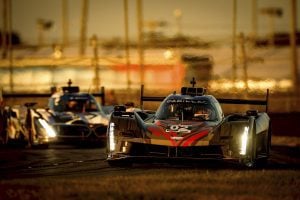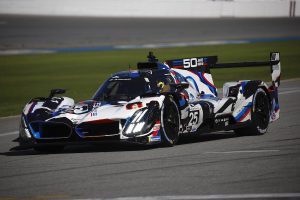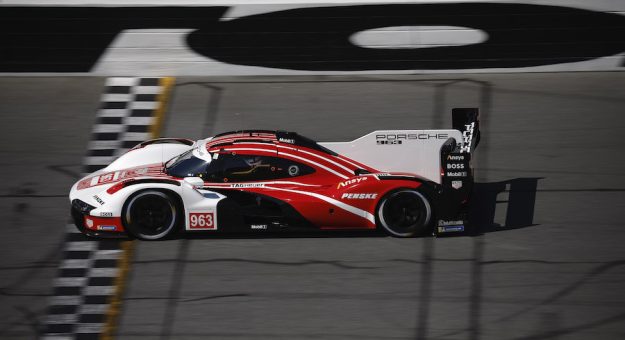A new era of prototype sports car racing will grace the high banks of Florida’s Daytona Int’l Speedway Jan. 28-29 during the 61st running of the Rolex 24 At Daytona.
America’s premier endurance race will witness the return of the GTP class to IMSA’s ranks, the name being a throwback to the prototype heyday of the late 1980s and early ’90s when Porsche, Nissan, Jaguar and Toyota competed with some of the most-advanced sports cars of the day.
With Porsche, Cadillac, Acura and BMW competing against each other in this year’s WeatherTech SportsCar Championship, and Lamborghini joining the GTP field in 2024, let’s dive into IMSA’s new generation of prototype sports cars.

Announced at the 2020 Rolex 24 as LMDh (Le Mans, Daytona and the h was not defined), the latest prototype specs are aimed at convergence with the new LMH (Le Mans Hypercar) rules that the FIA had already introduced for the World Endurance Championship.
The goal is to have the prototypes built to the American LMDh specifications competing on the same track against cars built to the LMH rules.
LMDh cars will gain eligibility to race at the 24 Hours of Le Mans and the rest of the FIAWEC while LMH cars can race in IMSA competition. Toyota, Ferrari, Peugeot and other LMH manufacturers will now be able to race their machinery against the best cars that the American regulations can provide.
In January 2022, IMSA announced the Prototype class would be renamed GTP, with LMDh being retained as the name for the car build rules for the new class, which replaces Daytona Prototype International.
The LMDh regulations call for a manufacturer to design a car around a tub built for the LMP2 class. For reference, the LMP2 class is a cost-capped prototype class with a pro/am driver lineup. There is a single engine supplier and multiple homologated chassis designs.
For LMDh, a manufacturer must design bodywork, an engine and transmission around a tub manufactured by either Oreca (partnering with Acura), Dallara (BMW and Cadillac), Multimatic (Porsche) or Ligier (Lamborghini).
While it sounds very similar to DPi, there are some changes under the surface as IMSA President John Doonan explained.
“The intent from day one was to take what we did in DPi and open up the aero box, if you will, from a styling standpoint,” Doonan said. “So allow more styling in the side pods and the tail and give the manufacturers a chance to take it to the next level with their design teams such that when you look at any of these cars, you see the brand that it represents. That is the heart of the matter, that’s what it all stands for. I think in addition to that, the integration of a hybrid powertrain system is something that the manufacturers, as we remain a marketing platform for them, wanted and continue to need those types of stories to represent what they’re doing in their road car lineups to, again, tell their brand story, tell a sustainability story, and a real one at that.”
The cars will utilize a spec hybrid system with parts sourced from Bosch, Xtrac and Williams Advanced Engineering that will provide additional power under acceleration. While secrecy among competing manufacturers is usually at a premium, each manufacturer has been open with IMSA about hybrid-system issues that have surfaced during testing.

To prevent any kind of testing shut down due to a hybrid system issue, IMSA wanted manufacturers to work together to make sure testing would not be interrupted by parts shortages or reliability concerns. The manufacturers heeded IMSA’s wishes and cooperated with each other.
“Some of the OEMs didn’t have a battery or an electric motor and there was a lot of sharing to make sure people could get out and get mileage on their car and the installation of that system in their car,” Doonan said. “So you have probably one of the most historic collaborations to get a program to the right place.
“Porsche was further along in terms of getting a car on track so they became your pilot customer, if you will. And so, they had the opportunity to get out, test any issues that they faced. They ultimately reported back to Bosch and to the other OEMs and then as the other OEMs got on track, same thing. The system, because it’s the same for everyone, needs to operate properly.”
All new mechanical systems require numerous miles of on-track testing in order to sort out any reliability concerns and each manufacturer has been hard at work making their cars as close to bulletproof as possible.
Porsche was the first manufacturer to test its new car in January 2022 at their factory test track in Weissach, Germany. The 963, named as a successor to the ultra-successful 962, has completed several test sessions at numerous tracks around the world, culminating in a marathon 36-hour test at Sebring (Fla.) Int’l Raceway. During that test, the 963 completed more than 4,500 miles on one of the bumpiest circuits in sports car racing.
Porsche will have Team Penske as a factory team. The two companies most notably worked together on the RS Spyder program in the American Le Mans Series. Team Penske will compete with two cars in IMSA. Porsche will also have two customer teams competing in IMSA in 2023 with JDC-Miller Motorsports and Proton Competition each running one car.
Cadillac was the most successful manufacturer during the DPi era with three championships and a dozen endurance victories. Two teams will race the new V-LMDh machine, with Action Express Racing fielding a single car and Chip Ganassi Racing entering two cars. Cadillac has completed several tests with the car, including a 24-hour run at Sebring.
BMW has completed numerous tests in America and Europe as Rahal Letterman Lanigan Racing continues its relationship with the German brand with two BMW M Hybrid V-8 machines based out of Zionsville, Ind.
Acura tested its new ARX-06 in France before shipping the first car to the U.S. Wayne Taylor Racing and Meyer Shank Racing will each run one car this season, but the teams had a unique situation as they initially had to share one car for testing. Each team now has its own cars.
It is worth noting that Alpine is building a car to LMDh regulations with an Oreca tub, but they will be competing in the FIAWEC. That doesn’t mean the car can’t show up in IMSA competition once Alpine feels it is ready to compete.
Fans and manufacturers alike have been hoping for years that a convergence in prototype sports car regulations would allow one car to compete globally across different rulebooks, as was the case during the 1980s and ’90s in the old GTP era.
“I think we’re giving the fans; we’re giving the automakers what they’ve wanted and asked for,” Doonan said. “And if the ’80s and early ’90s were the golden era, I think we’re entering the platinum era.”
This story appeared in the Jan. 18 edition of the SPEED SPORT Insider.

